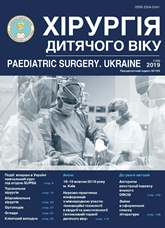Surgical treatment of hepatoblastoma
DOI:
https://doi.org/10.15574/PS.2019.63.29Keywords:
hepatoblastoma, children, liver resection, liver transplantationAbstract
Objective. To study and improve the results of surgical treatment of children with hepatoblastoma.
Materials and methods. The experience of surgical treatment of 90 children with hepatoblastoma is presented: 81 patients who underwent liver resection,
and in 9 cases with a nonresectable hepatoblastoma a living-donor liver transplantation was performed.
Results. More severe postoperative complications (from ІІІ-b to V degree according to Dindo–Clavien) were observed in the resection group of patients. Postoperative mortality after liver resection was 5% (n=4), and there were no lethal cases after liver transplantation. The 5-year relapse-free survival rate in the transplant group was 69.2% versus 62.5% in the resection group, and the overall survival rate was 75% versus 71%, respectively.
Conclusions. Resection and transplantation technologies are effective methods of surgical treatment of hepatoblastoma in children, and in combination with chemotherapy, they can produce a good long-term results. The immediate and long-term results after liver transplantation are better than after liver resection, even though transplantation group patients have a larger tumor lesion in the liver. Liver transplantation is a good treatment option for children with unresectable hepatoblastoma.
References
Ane Andres, Francisco Hernandez, Carlos Sanchez-Montenegro, Martha Romo et al. (2017, Jun). Primary multivisceral transplantation in a child with hepatoblastoma and portomesenteric thrombosis. Transplantation. 101;62: 113. https://doi.org/10.1097/01.tp.0000521452.66335.fe
Aronson DC, Czauderna P, Maibach R, Perilongo G, Morland B. (2014, Oct.). The treatment of hepatoblastoma: Its evolution and the current status as per the SIOPEL trials. J Indian Assoc Pediatr Surg.19(4): 201–7. https://doi.org/10.4103/0971-9261.142001; PMid:25336801 PMCid:PMC4204244
Czauderna P, Otte JB, Aronson DC, Gauthier F et al. (2005, May). Guidelines for surgical treatment of hepatoblastoma in the modern era – recommendations from the Childhood Liver Tumour Strategy Group of the International Society of Paediatric Oncology (SIOPEL). Eur J. Cancer.41(7): 1031–36. https://doi.org/10.1016/j.ejca.2005.02.004; PMid:15862752
Derek J. Roebuck, Daniel Aronson, Philippe Clapuyt, Piotr Czauderna et al. (2007, Feb.). 2005 PRETEXT: a revised staging system for primary malignant liver tumours of childhood developed by the SIOPEL group. Pediatr Radiology. 37(2): 123–132. https://doi.org/10.1007/s00247-006-0361-5; PMid:17186233 PMCid:PMC1805044
Hishiki Tomoro (2013, Dec.). Current therapeutic strategies for childhood hepatic tumors: surgical and interventional treatments for hepatoblastoma. International Journal of Clinical Oncology.18(6): 962–68. https://doi.org/10.1007/s10147-013-0625-7; PMid:24132546
Inbal Samuk, Akin Tekin, Panagiotis Tryphonopoulos, Ignacio G. Pinto et al. (2016, Apr.). Abdominal transplantation for unresectable tumors in children: the zooming out principle. Pediatric Surgery International. 32(4): 337–46.
Marcio M. Malogolowkin, Howard M. Katzenstein, Rebecka L. Meyers, Mark D. Krailo et al. (2011, Aug 20). Complete Surgical Resection Is Curative for Children With Hepatoblastoma With Pure Fetal Histology: A Report From the Children’s Oncology Group. Journal of Clinical Oncology.29(24): 3301–3306.
Miyamura T, Yoshida R, Yagi T, Matsukawa H et al. (2011, Aug). Successful treatment of unresectable advanced hepatoblastoma: living liver transplantation after surgicalremoval of lung metastasis. Pediatr Transplant. 15(5): E87–91. https://doi.org/10.1111/j.1399-3046.2009.01262.x; PMid:20070564
Natsumi Tanaka, Takehisa Ueno, Yuichi Takama, Hiroaki Yamanaka et al. (2016). A Case of Hepatoblastoma With Main Portal Vein Invasion Successfully Treated by Living-Donor Liver Transplantation. Journal of the Japanese Society of Pediatric Surgeons. 52;4: 949–953.
Sakamoto S, Kasahara M, Mizuta K, Kuroda T et al. (2014, Mar). Nationwide survey of the outcomes of living donor liver transplantation for hepatoblastoma in Japan. Liver Transplantation. 20(3): 333–46. https://doi.org/10.1002/lt.23803; PMid:24734315
Downloads
Issue
Section
License
The policy of the Journal “PAEDIATRIC SURGERY. UKRAINE” is compatible with the vast majority of funders' of open access and self-archiving policies. The journal provides immediate open access route being convinced that everyone – not only scientists - can benefit from research results, and publishes articles exclusively under open access distribution, with a Creative Commons Attribution-Noncommercial 4.0 international license(СС BY-NC).
Authors transfer the copyright to the Journal “PAEDIATRIC SURGERY.UKRAINE” when the manuscript is accepted for publication. Authors declare that this manuscript has not been published nor is under simultaneous consideration for publication elsewhere. After publication, the articles become freely available on-line to the public.
Readers have the right to use, distribute, and reproduce articles in any medium, provided the articles and the journal are properly cited.
The use of published materials for commercial purposes is strongly prohibited.

